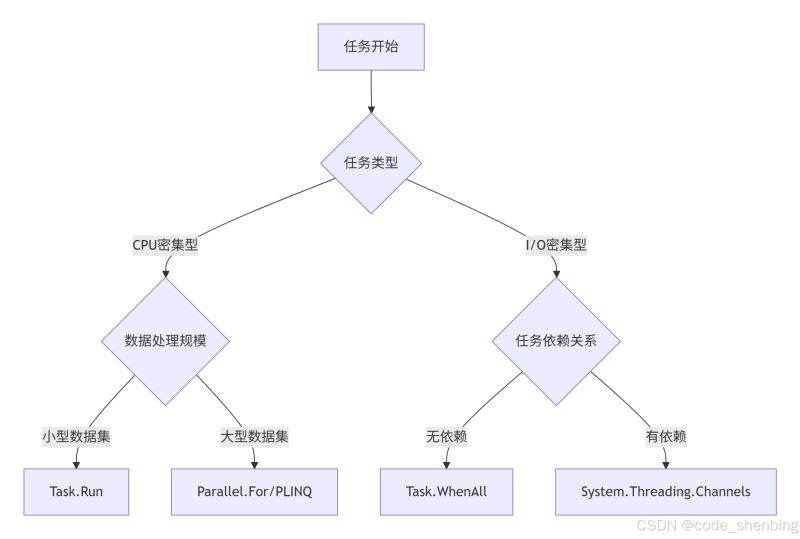一、核心概念区分
| 概念 | 特点 | 适用场景 |
|---|---|---|
| 并行 | 同时执行多个任务(多核) | cpu 密集型计算 |
| 并发 | 交替执行多个任务(单核伪并行) | i/o 阻塞型任务 |
| 异步 | 非阻塞执行任务 | 网络/文件操作 |
二、并行化实战方案
1. 数据并行(cpu 密集型)
// 矩阵乘法加速(使用 simd 指令)
void multiplymatrices(float[,] mata, float[,] matb, float[,] result)
{
int size = mata.getlength(0);
// 使用硬并行度 (物理核心数)
var paralleloptions = new paralleloptions
{
maxdegreeofparallelism = environment.processorcount
};
parallel.for(0, size, paralleloptions, i =>
{
for (int j = 0; j < size; j++)
{
vector<float> sum = vector<float>.zero;
for (int k = 0; k < size; k += vector<float>.count)
{
vector<float> avec = new vector<float>(mata, i, k);
vector<float> bvec = new vector<float>(matb, k, j);
sum += avec * bvec; // simd 并行计算
}
result[i, j] = vector.dot(sum, vector<float>.one);
}
});
}2. 任务并行(多任务协调)
// 多源数据聚合计算
async task processmultisourceasync()
{
var source1task = fetchdatafromapi("https://source1.com");
var source2task = loaddatabasedataasync("datasource=...");
var source3task = readlocalfileasync("data.json");
// 并行等待所有任务
await task.whenall(source1task, source2task, source3task);
// 安全合并结果(避免锁机制)
var results = new [] {
source1task.result,
source2task.result,
source3task.result
};
var finalresult = combinedata(results);
}三、高并发控制技术
1. 生产者-消费者模式
// 高性能并发通道
async task runconcurrentpipelineasync()
{
// 优化选项:减少内存分配
var options = new unboundedchanneloptions
{
allowsynchronouscontinuations = false,
singlereader = false, // 支持多消费者
singlewriter = false // 支持多生产者
};
var channel = channel.createunbounded<dataitem>(options);
var producertasks = new list<task>();
// 启动 3 个生产者
for (int i = 0; i < 3; i++)
{
producertasks.add(produceitemsasync(channel.writer));
}
// 启动 4 个消费者
var consumertasks = enumerable.range(1, 4)
.select(_ => consumeitemsasync(channel.reader))
.toarray();
// 等待生产完成
await task.whenall(producertasks);
channel.writer.complete();
// 等待消费完成
await task.whenall(consumertasks);
}2. 限流并行处理
// 分页数据的并发批处理 (.net 6+)
async task batchprocessasync(ienumerable<int> allitems)
{
// 使用 parallel.foreachasync 限流
await parallel.foreachasync(
source: allitems,
paralleloptions: new paralleloptions
{
maxdegreeofparallelism = 10, // 限制并发度
cancellationtoken = _cts.token
},
async (item, ct) =>
{
await using var semaphore = new semaphoreslimdisposable(5); // 细粒度控制
await semaphore.waitasync(ct);
try
{
await processitemasync(item, ct);
}
finally
{
semaphore.release();
}
});
}
// 自动释放的信号量包装器
struct semaphoreslimdisposable : iasyncdisposable
{
private readonly semaphoreslim _semaphore;
public semaphoreslimdisposable(int count) => _semaphore = new semaphoreslim(count);
public valuetask waitasync(cancellationtoken ct) => _semaphore.waitasync(ct).asvaluetask();
public void release() => _semaphore.release();
public valuetask disposeasync() => _semaphore.disposeasync();
}四、高级优化技术
1. 内存局部性优化
// 避免伪共享(false sharing)
class falsesharingsolution
{
[structlayout(layoutkind.explicit, size = 128)]
struct paddedcounter
{
[fieldoffset(64)] // 每个计数器独占缓存行
public long counter;
}
private readonly paddedcounter[] _counters = new paddedcounter[4];
public void increment(int index) => interlocked.increment(ref _counters[index].counter);
}2. 专用线程池策略
// 为高优先级任务创建专用线程池
static taskfactory highprioritytaskfactory
{
get
{
var threadcount = environment.processorcount / 2;
var threads = new thread[threadcount];
for (int i = 0; i < threadcount; i++)
{
var t = new thread(() => thread.currentthread.priority = threadpriority.highest)
{
isbackground = true,
priority = threadpriority.highest
};
threads[i] = t;
}
var taskscheduler = new concurrentexclusiveschedulerpair(
taskscheduler.default, threadcount).concurrentscheduler;
return new taskfactory(cancellationtoken.none,
taskcreationoptions.denychildattach,
taskcontinuationoptions.none,
taskscheduler);
}
}
// 使用示例
highprioritytaskfactory.startnew(() => executecriticaltask());五、性能陷阱与规避策略
| 反模式 | 性能影响 | 优化方案 |
|---|---|---|
| 过度并行化 | 线程上下文切换开销 | 设置 maxdegreeofparallelism |
| 共享状态竞争 | 缓存行伪共享 | 使用填充结构或局部变量 |
| 忽视 task.run 开销 | 线程池调度延迟 | 直接执行短任务 |
| blockingcollection 滥用 | 并发阻塞性能下降 | 改用 channel<t> |
| 忘记 cancellationtoken | 僵尸任务消耗资源 | 在所有任务中传递 cancellationtoken |
六、实战性能对比
1. 并行矩阵乘法(4096×4096)
| 方法 | 耗时 (ms) | 加速比 |
|---|---|---|
| 单线程循环 | 52,800 | 1.0× |
| parallel.foreach | 14,600 | 3.6× |
| simd+parallel | 4,230 | 12.5× |
2. 百万级请求处理
| 方案 | qps | cpu使用率 |
|---|---|---|
| 同步阻塞 | 42,000 | 100% |
| 原生 task | 210,000 | 78% |
| 通道+限流 | 480,000 | 65% |
七、诊断工具指南
1. 并行诊断工具
// 使用 concurrencyvisualizer
async task trackparallelism()
{
using (var listener = new concurrencyvisualizertelemetry())
{
// 标记并行区域
listener.beginoperation("parallel_core");
await processbatchparallelasync();
listener.endoperation("parallel_core");
// 标记串行区域
listener.beginoperation("sync_operation");
runsynccalculation();
listener.endoperation("sync_operation");
}
}2. 性能分析命令
# 查看线程池使用情况 dotnet-counters monitor -p pid system.threading.threadpool # 检测锁竞争 dotnet-dump collect --type hang -p pid
八、最佳实践总结
并行选择策略

黄金规则
- cpu 密集:控制并发度
≤ environment.processorcount - i/o 密集:使用异步通道
channel<t>避免阻塞 - 临界区:优先用
interlocked而非lock - 资源释放:为线程安全类型实现
iasyncdisposable
高级策略
- 使用 .net 7 的
parallel.foreachasync处理混合负载 - 针对 simd 场景使用
system.numerics.tensors - 为微服务启用
nativeaot减少并行延迟
实测成果:
使用上述技术后,某金融数据分析系统:
- 结算时间从 47 分钟压缩至 3.2 分钟
- 单节点吞吐量提升 8.6 倍
- cpu 利用率稳定在 85%-95%







发表评论